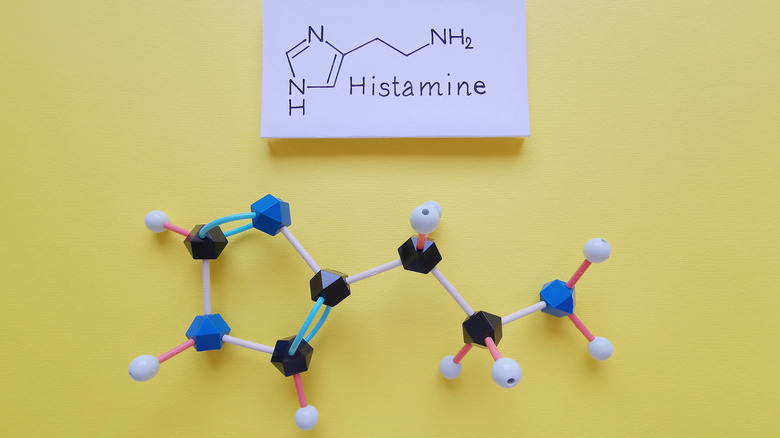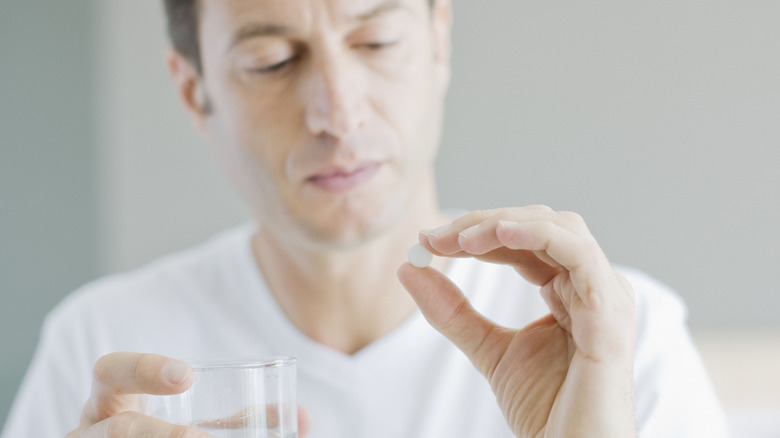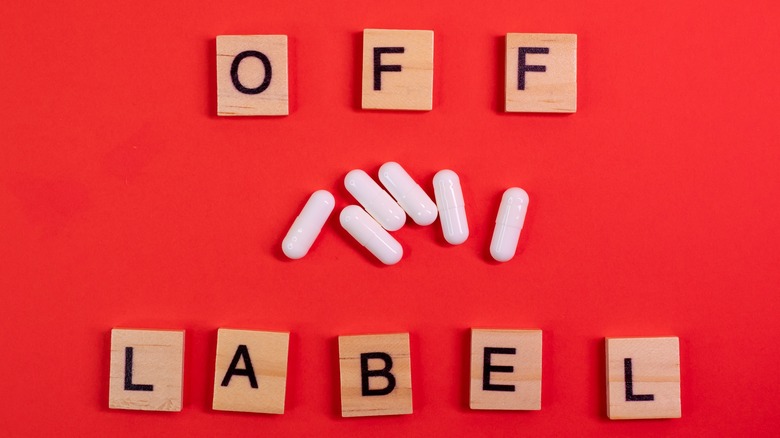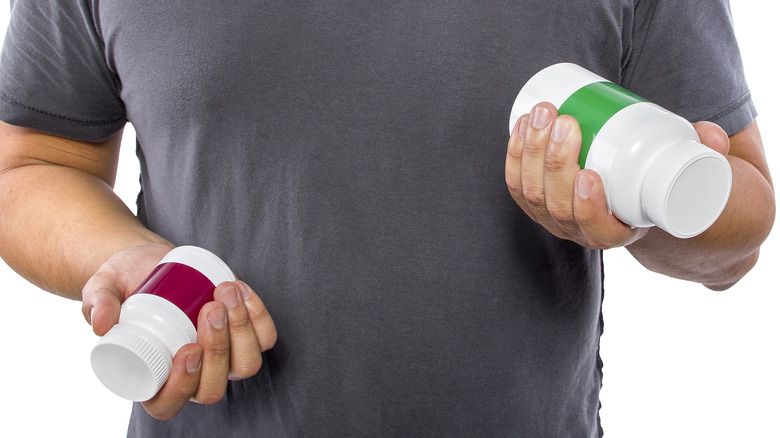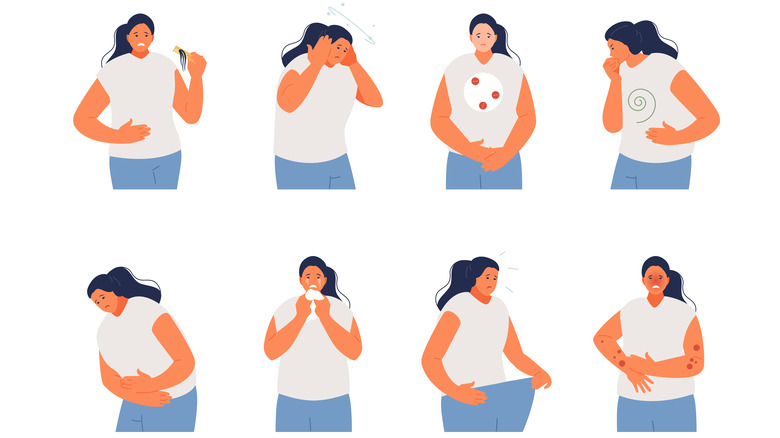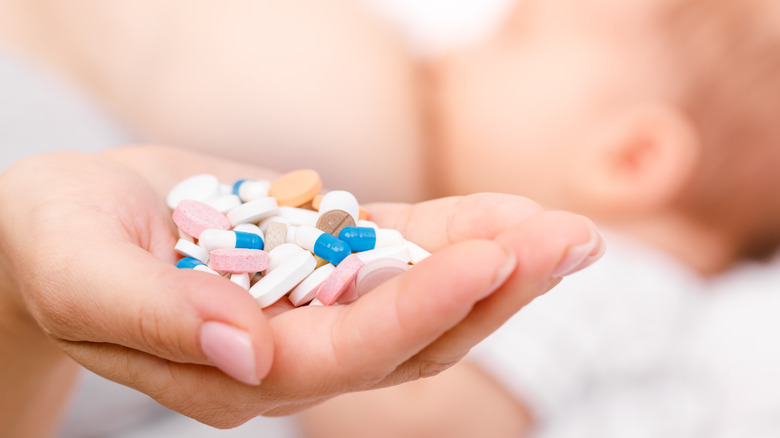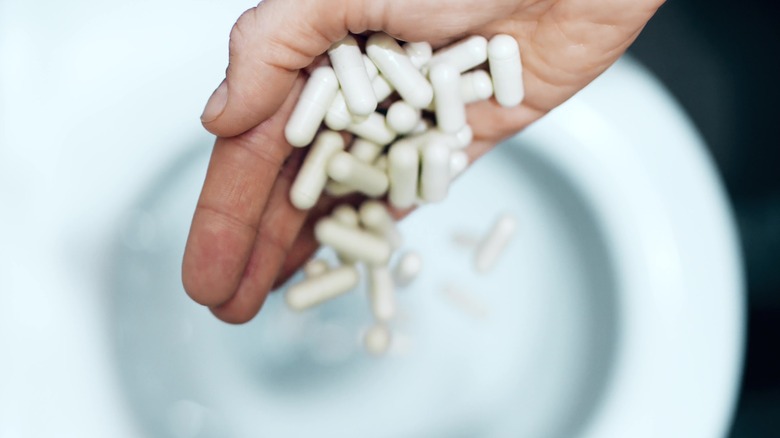Hydroxyzine Explained: Usage, Doses, And Side Effects
Picture this: You are going about your day as you normally would, then you see or hear something that makes you suddenly think of the words "itch" or "scratch". What are the chances that your brain just tricked you into thinking that some part of your body actually is itching and needs to be scratched? Sneaky, isn't it? But why do we experience this uncomfortable sensation? And why does it seem so hard to stop scratching once you start?
As all of us know, itchiness is a very unpleasant and annoying thing to deal with. Not only does constant scratching cause breaks in the skin, but it can also lead to scarring, bleeding, and infections. According to Medical News Today, scratching actually produces a mild painful sensation, which signals the brain to release a chemical called serotonin to control the pain. But this becomes counterintuitive, because serotonin can also intensify the feeling of itchiness and cause you to scratch even more. It then turns into a cycle that begins when you scratch an itch, and will only end once you stop scratching.
The American Academy of Dermatology (AAD) Association lists the different things that can cause an itch. These include dry skin, insect bites, skin conditions and infections, skin cancer, allergic reactions, aging (i.e., being 65 years or older), some medications, nerve problems, and certain medical problems. But what majority of these have in common is the overabundance of a chemical called histamine — one of the main causes of itching.
Hydroxyzine is an antihistamine
Histamine is released into the bloodstream by white blood cells (e.g., mast cells, basophils) of the immune system (via Healthgrades). When your body gets exposed to an allergen (e.g., pollen, dust, animal dander), your immune system interprets this as harmful to your body and will attempt to remove it. This is done through a series of simultaneous and consecutive processes, with mast cell release of histamine being one of them.
Once histamine is released, it expands your blood vessels to promote an increase in blood flow, and subsequently lead to inflammation and allow more substances from the immune system to travel to where the allergen is located. Inflammation in this case is good, as it means that your body is attempting to repair itself. However, according to UNC Health Talk, it becomes harmful when the inflammatory process continues unchecked, or if the immune system mistakenly tags a harmless substance as harmful (as is the case for autoimmune diseases like lupus, rheumatoid arthritis, and psoriasis).
As an antihistamine, hydroxyzine works by blocking the release of histamine, which therefore prevents histamine from exerting its effects on the body. Hydroxyzine can come in many forms including tablet, capsule, syrup, and injection (per LiverTox). Brand names include Vistaril, Atarax, Hyzine, Vistazine, and Rezine. Drugs.com adds that multidrug medications also exist that consist of hydroxyzine combined with ephedrine and theophylline. These medications are mostly used for asthma and may be more recognizable by their brand names (e.g., Marax, Hydrophed, Ami-rax).
Difference between H-1 and H-2 antihistamines
Histamine attaches to receptors to exert its effects (via Healthgrades). Four types of histamine receptors exist: H1, H2, H3, and H4. The receptor at which histamine binds to determines its effect on the body. Binding to H1 receptors can lead to pain, itchiness, flushing of the skin, and breathing difficulties. It also plays a role in regulating your emotions, memory, sleep patterns, and ability to learn. They can be found throughout the body, embedded in your blood vessels, nerve cells, and airway muscle cells. On the other hand, binding to H2 receptors can cause hyperacidity, headaches, and fast heartbeats. Meanwhile, binding to H3 receptors affects the production and release of histamine. Lastly, binding to H4 receptors controls the release and function of white blood cells from the bone marrow.
Antihistamines bind to the same receptors as histamines, but exert an opposite effect. They mostly bind to either H1 or H2. StatPearls refers to them as H-1 antihistamines and H-2 antihistamines, respectively. H-1 antihistamines are mainly used to treat allergy symptoms. Additionally, they are further divided into first- and second-generation antihistamines. The key difference between the two lies in their ability to travel to the brain. First-generation antihistamines are able to diffuse from the blood into the brain and cause sedation, while second-generation antihistamines do not. Hydroxyzine is a first-generation H-1 antihistamine. H-2 antihistamines, on the other hand, are mainly used to treat gastric problems such as acid reflux, ulcers, nausea, vomiting, and motion sickness.
Hydroxyzine as a treatment option for itching
Authors of a 2008 article published in Molecular Pain explain that histamine can cause itching by activating specific nerve fibers present in the superficial layers of the skin. As an antihistamine, hydroxyzine is able to block this effect and relieve itchiness. However, it is important to note that itchiness can also be activated by substances other than histamine. Therefore, in the same regard, antihistamines are also not the only thing that can relieve itchiness.
The U.S. Food and Drug Administration (FDA) has long approved the use of hydroxyzine as treatment for itching caused by atopic dermatitis, allergies, and other similar conditions (via Medical News Today). It exists as 5, 25, and 50 milligram dosages in tablet form; 25, 50, and 100 milligrams in capsule form; 10 milligrams per 5 milliliters in syrup form; and 25 and 50 milligrams per 5 milliliters in activating form. Adults can take or be given 25 milligrams of hydroxyzine in oral or injectable forms every six to eight hours; while children younger than six years old should only be given 50 milligrams per day of oral hydroxyzine, divided every six hours. This can be increased to up to 100 milligrams per day of oral hydroxyzine (also divided every six hours) in children six years or older.
Other uses for hydroxyzine
Given that hydroxyzine causes sedation, it can be given as a sedative to people before they undergo surgery. Adults can be given 50 to 100 milligrams of oral hydroxyzine per day, while children are limited to 0.6 milligrams per kilogram of their body weight per day (per Mayo Clinic). Hydroxyzine can also be used in the management of anxiety, tension, and alcohol withdrawal symptoms such as nausea. According to GoodRx Health, although the mechanism behind hydroxyzine in the context of relieving anxiety is still unclear, it is very likely that it has something to do with hydroxyzine's effect on histamine and serotonin.
Serotonin is one of the many chemicals the brain uses to transmit and receive messages to and from your whole body. It is responsible for regulating your mood, sleep cycles, digestive processes, wound healing, bone turnover, and sex drive. Several mental health conditions are associated with low serotonin levels, such as depression, phobias, and anxiety (per Cleveland Clinic). Similar to other medications used to treat these conditions, it is believed that hydroxyzine is able to attach to certain serotonin receptors, thereby influencing the level of serotonin in the body (per GoodRx Health). Adults are typically given 50 to 100 milligrams (capsule, tablet, or syrup form) four times a day, while children younger than six years old are only given 50 milligrams per day divided into several doses. Children six years or older can be given up to 100 milligrams a day in divided doses (via Mayo Clinic).
Off-label uses for hydroxyzine
Sometimes, a doctor may prescribe medications approved by the FDA for a condition or symptom that they are not necessarily indicated for. These are referred to as off-label uses. The FDA explains that when a certain drug is FDA-approved, it means that the manufacturer of that drug was able to prove that it is safe and effective to use. Sometimes, it can also mean that the therapeutic benefits of an approved drug far outweigh its possible side effects. Technically speaking, once the FDA approves a certain drug, doctors and other providers are allowed to prescribe it for purposes outside of its intended use. But this is only if they believe, in their professional opinion, that the drug will be beneficial to their patient, or if other, more appropriate treatment options have been ineffective.
Hydroxyzine can be prescribed off-label to help with sleep problems. However, while hydroxyzine can cause sedation as a side effect, Healthline warns that it can also cause insomnia. Another off label use for hydroxyzine is taking it long-term for anxiety. Even though the use of hydroxyzine for anxiety is FDA-approved, it is approved only if you are taking it for less than four months (per Drugs.com). The American Academy of Family Physicians (AAFP) adds that hydroxyzine can also sometimes be used to treat a condition called interstitial cystitis (i.e., chronic bladder pain syndrome). Studies show that it is effective in relieving symptoms, possibly due to its ability to block and dampen histamine receptors.
What to take note of before taking hydroxyzine
All of us should be aware of what we put in our bodies, be it food, beverages, chemicals, or medicines. Taking hydroxyzine is no different. It goes without saying that when it comes to managing your health, it is always best to consult with your doctor first, especially if you plan on taking any type of medication (including over-the-counter products).
If you were prescribed or are planning to self-medicate with hydroxyzine, MedlinePlus advises you to take a step back and make sure that it is safe for you to do so. You can do this by telling your provider if you have any allergies to antihistamines or their ingredients; keeping a complete list of all medications and supplements you are taking to allow your provider to cross-check their interactions with one another; letting your doctor know if you have heart rhythm problems; making sure that you will not have to drive or operate any machinery after taking the drug, as it can make you drowsy and cause accidents; and informing your doctor if you are pregnant, breastfeeding, or regularly drinking alcohol. You should also avoid taking hydroxyzine if you are over 65 years old, as you are more prone to developing side effects.
WebMD adds that you should let your provider know what health conditions you have (or had), such as seizures, breathing problems, glaucoma, high blood pressure, liver problems, kidney disease, gut abnormalities, overactive thyroid, and bladder or prostate problems.
Medications and other substances that interact with hydroxyzine
RxList categorizes drugs and other substances that interact with hydroxyzine according to severity. Substances that cause mild interactions with hydroxyzine include ashwagandha, eucalyptus, nettle, sage, and siberian ginseng. The glaucoma drug brimonidine also mildly interacts with hydroxyzine. Serious interactions may happen if taking hydroxyzine with citalopram, clozapine, fluoxetine, droperidol, eluxadoline, iloperidone, isocarboxazid, tranylcypromine, ziprasidone, procainamide, amiodarone, quetiapine, sotalol, and sodium oxybate. Addiction Resource adds that taking hydroxyzine may also cause problems when taken with alcohol, marijuana, other antihistamines, caffeine, and opioids.
If you were prescribed hydroxyzine by your provider and you found that another drug you are taking potentially interacts with it, it will not hurt to double-check with them or your pharmacist if you feel hesitant to take the medication. It is best to do this before taking hydroxyzine, as you should not prematurely start or stop taking any drug, or modify the way you take it, based on what is recommended or prescribed to you. Chances are, however, that your provider and pharmacist already know about the possible interactions, and they are monitoring you closely or deemed it safe for you to take.
Side effects of hydroxyzine
The side effects of hydroxyzine can range from mild to severe. Mild side effects usually occur in adults younger than 60 who are not on any other medication and have no preexisting conditions. These mild side effects include drowsiness or sleepiness, slow reaction time, dry mouth, mild skin rash, headache, hallucinations, constipation, confusion, lack of energy, weakness, problems with sleeping, difficulty concentrating, and mild drops in blood pressure. These mild problems are usually easy to fix and prevent. For example, the sedative effects of hydroxyzine typically resolve after a few days of taking them. If you still continue to feel sleepy, your prescribed dose may be lowered or you may be given a different type of drug.
On the other hand, although not common, serious side effects can lead to a medical emergency and treatment may be needed as soon as possible to prevent the development of further complications. Serious side effects include the development of heart rhythm abnormalities (e.g., torsades de pointes, acquired long QT syndrome), life-threatening allergic reactions, and severe skin reactions that may cause high fever, blisters, pustules, discolored skin, and skin irritation (via Healthline). These include angioedema, erythema multiforme, pemphigoid, acute generalized exanthematous pustulosis (AGEP), Stevens-Johnson syndrome, and toxic epidermal necrolysis.
Can I take hydroxyzine while pregnant or breastfeeding?
Currently, there is still not enough research that fully illustrates how taking hydroxyzine affects pregnancy. While Medical News Today states that studies on animals have shown that it can in fact cause harm to unborn babies, according to Drugs.com, these studies used doses of hydroxyzine that are well above what we give to humans for treatment purposes. Furthermore, to this day, no reliable studies have been conducted on human pregnancies.
However, some authorities consider hydroxyzine to be contraindicated in early pregnancy because the drug is able to cross the placenta and cause hydroxyzine to settle in the unborn baby's circulation more than the pregnant mother's. There have also been reports on the effect of hydroxyzine in late pregnancy, labor, and delivery. Some babies who were exposed to hydroxyzine during this time developed depression of their central nervous system, repeated jerking movements, abnormal movement symptoms, low blood pressure, hypoxia, and urinary retention. It is therefore safe to say that women who are pregnant or become pregnant while taking hydroxyzine should not take the drug, especially when there are other safer alternatives that they can take instead.
The same holds true if you are breastfeeding. You should not take hydroxyzine because the drug is able to diffuse into breast milk, causing severe side effects in newborns.
Addictive potential of hydroxyzine
Unlike other common drugs used to treat anxiety such as benzodiazepines (e.g., alprazolam, clonazepam, lorazepam), hydroxyzine itself is not considered an addictive drug. However, it is possible for people to abuse it and subsequently, they may even overdose from it. This mostly occurs when it is mixed with other addictive drugs (e.g., opioids) whereby hydroxyzine becomes psychologically and dually addictive (via Better Addiction Care).
People who develop an addiction to hydroxyzine may not realize their dependence on it until later on. This is partly due to the fact that hydroxyzine is not naturally addictive and it is fairly easy for people to buy them over-the-counter. However, addiction is not merely a dependency on controlled substances. According to Psychology Today, addiction happens when a person repeatedly uses any substance or engages in any behavior for its rewarding effects, despite the consequences that they may experience.
Northpoint Washington lists the things you should pay attention to in terms of your hydroxyzine intake habits that may point to dependence. Among these include relationship problems stemming from your drug intake, hiding your medicine use from your loved ones, experiencing withdrawal symptoms, feeling like you are not able to stop taking the drug, constantly worrying about not having enough of it on hand, and progressively increasing the amount you take to experience the same effects.
If you or anyone you know needs help with addiction issues, help is available. Visit the Substance Abuse and Mental Health Services Administration website or contact SAMHSA's National Helpline at 1-800-662-HELP (4357).
Overdosing on hydroxyzine
Overdosing on hydroxyzine can occur if you accidentally or intentionally take too much of it, or more than what is prescribed by your doctor. This can happen with all forms of hydroxyzine, including multidrug medications that contain hydroxyzine. You may develop numerous signs and symptoms all over your body, including dry skin, flushing, blurring of vision, dilated pupils, dry eyes, ringing in the ears, dry mouth, fast heartbeat, low blood pressure, palpitations, nausea, vomiting, difficulty breathing, problems with urinating, agitation, seizures, delirium, hallucinations, dizziness, problems with balance and coordination, drowsiness, disorientation, nervousness, excitement, tremors, depression, and difficulty sleeping. You may also slip into a coma and become unresponsive.
If you or someone you know overdosed on any drug, seek medical help as soon as you can. Call the toll-free national poison hotline (1-800-222-1222), and they can connect you to your local poison control center who can tell you exactly what to do. This hotline can also be reached even during non-emergency situations (e.g., inquiries about poisoning) and they are always available, night or day. If you are told to go to the emergency room, bring the container of the drug that was taken if you are able to. Death from a hydroxyzine overdose is very rare and is often seen in people who have underlying heart rhythm abnormalities, breathing problems, and those who do not get better after 24 hours of appropriate treatment. Complications that can occur include pneumonia, muscle damage, and brain damage (per MedlinePlus).
Hydroxyzine alternatives for itching
Some of the reasons why you may want to (or should) look for alternatives to hydroxyzine include inability to tolerate the medication due to its side effects, not getting its desired effects, having underlying conditions that can cause the drug to accumulate in your body, having too many other medications, and developing a dependency for it. Hydroxyzine is particularly unsuitable for adults over the age of 65 because they are more prone to developing side effects.
Cigna recommends safer alternatives for seniors such as levocetirizine, desloratadine, azelastine, fluticasone, and nasonex for allergic rhinitis; and ammonium lactate, levocetirizine, desloratadine, and topical steroids for generalized itching. Medical News Today adds that in the general population, hydroxyzine can also be replaced with diphenhydramine (e.g., Benadryl), loratadine (e.g., Claritin), corticosteroids (e.g., hydrocortisone), topical tacrolimus (e.g., Protopic), topical menthol, and topical capsaicin.
You can also relieve itchy skin at home by applying an ice pack or a cool, damp cloth on the affected areas, taking an oatmeal bath, moisturizing with lotions that have no fragrances and other additives, and applying products that contain pramoxine (for a numbing sensation) or calamine (for a cooling effect), via the AAD association.
Hydroxyzine alternatives for anxiety
There are many classes of drugs that are able to treat anxiety. However, not all of them work the same way. At times, some types of drugs work well for someone, while others do not. Hydroxyzine is only sometimes prescribed to treat anxiety symptoms. More common ones include selective serotonin reuptake inhibitors (SSRIs), serotonin norepinephrine reuptake inhibitors (SNRIs), tricyclic antidepressants (TCAs), benzodiazepines, and buspirone. Gabapentin, pregabalin, and propranolol are also sometimes used (via PsychCentral).
SSRIs (e.g., fluoxetine, citalopram, sertraline), SNRIs (e.g., venlafaxine, duloxetine), TCAs (e.g., amitriptyline, nortriptyline), and buspirone block specific receptors which increase the levels of serotonin and/or norepinephrine in the body. These drugs take four to six weeks to take effect, but they are not addictive. On the other hand, benzodiazepines work almost immediately, but they are addictive and can cause major side effects (per Psychology Today). Gabapentin and pregabalin work the same way although their exact mechanism is still unclear. Similar to propranolol, they are used off-label for several anxiety disorders.
As is the case with any type of medication, always consult with your doctor to prevent any unwanted side effects. They can help you determine what treatment is appropriate for your specific condition and what is not. Apart from therapy and medications, some things you can do at home that may help include eating a balanced diet, exercising regularly, avoiding alcohol and illicit drugs, quitting smoking, reducing caffeine intake, managing your stress, practicing relaxation techniques, and getting enough sleep (via Mayo Clinic).


